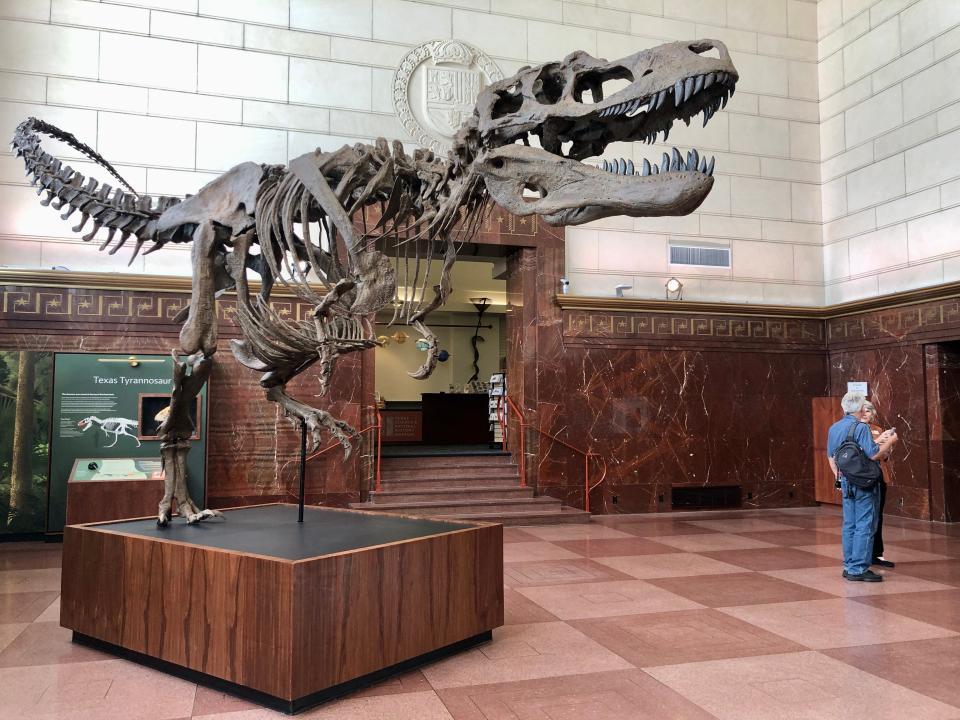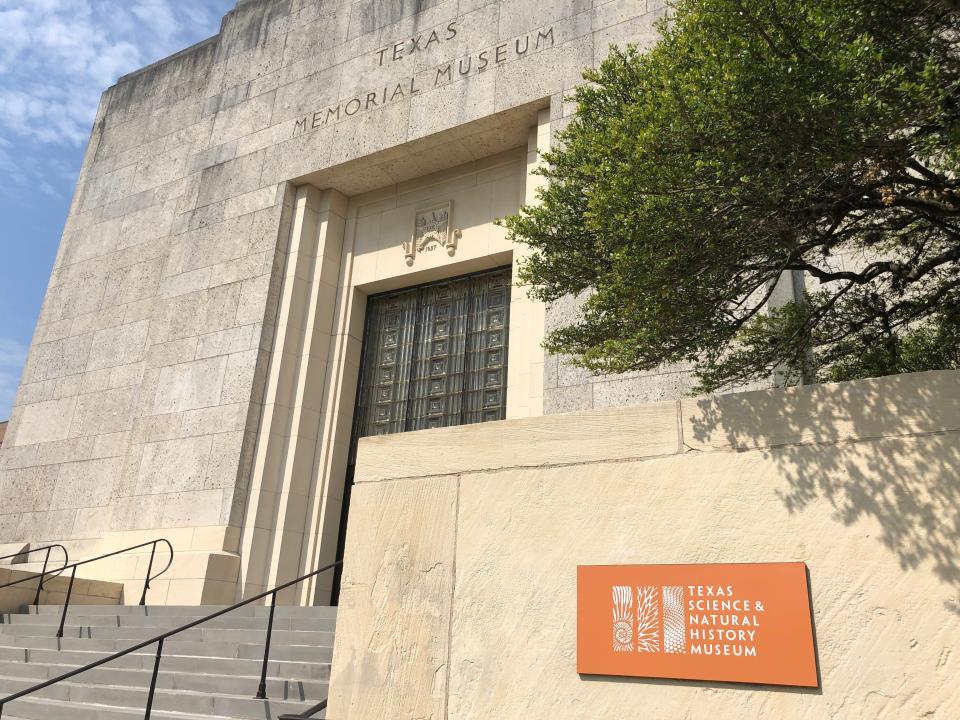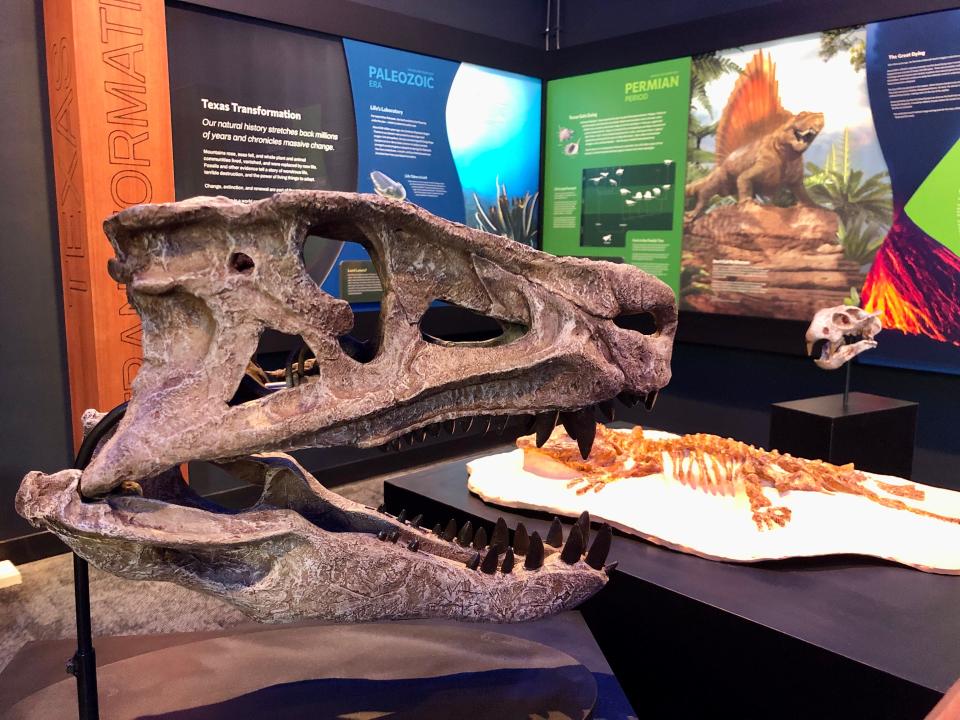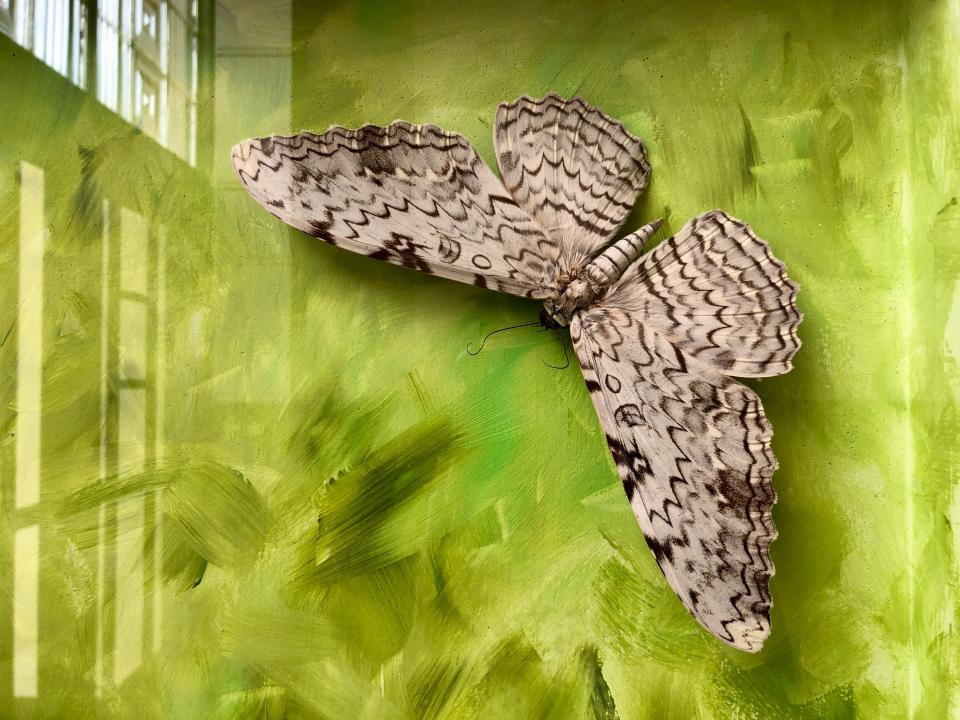Grumet: Texas Science & Natural History Museum reopens with a new star attraction
I’ve never been so happy to see an apex predator.
But there it was: A new Texas tyrannosaur stalking the great hall of the Texas Science & Natural History Museum, a marquee addition signaling this museum is ready to reopen after surviving its own near-extinction event.
“We’ve gone through an evolution,” managing director Carolyn Connerat said this week, showing off a museum with a new name, new murals, new interactive displays, a new gallery covering 600 million years of life in Texas — and yes, that fierce new tyrannosaur.
The museum has undergone a stunning transformation from where it was 18 months ago, when I first reported on the temporary closure of the place known for nearly a century as the Texas Memorial Museum. Generations of families and field-trip groups loved the museum’s prehistoric fossils and wildlife dioramas, but that wasn’t enough to stave off state budget cuts, dwindling staff and an uncertain future.

Connerat took over, and with the help of an advisory group, put together a plan to make the museum financially self-sustaining in a few years. The University of Texas, which owns the museum, invested in a reboot, and the Legislature this year kicked in $8 million — underwriting the building upgrades and modernized exhibits aimed at drawing more visitors and revenue-generating events.
You can see much of that investment in and around the great hall. A brand new “Texas Transformation” gallery (formerly office space) features newly exhibited fossils and a fascinating four-minute time-lapse animation showing how the Texas landscape has shifted over the eons. Another display compares bison (here for hundreds of thousands of years) with the longhorn cattle that arrived in the 1500s.
“Longhorn cattle aren’t from Texas,” the display says, “but they got here as fast as they could.”

‘A fabulous animal from Big Bend’
Still, the star of the reboot is the Texas tyrannosaur, lurking in the same great hall that features the giant winged pterosaur, Quetzalcoatlus.
The 33-foot-long reconstructed skeleton of the Texas tyrannosaur, based on an upper jawbone found in West Texas and a body of a similar-sized dinosaur found elsewhere, is bound to stir imaginations and spark questions. Even paleontologists are debating what this creature was.
Given its relatively smaller size, was this a teenage T. Rex? Or maybe another species?
“No matter what you call it, it's a fabulous animal from Big Bend,” Pamela Owen, the museum’s associate director, said with unmistakable Texas pride.

New murals bring these creatures to life. On one wall, a colorful pterosaur gulps water across the riverbank from a trio of triceratopses. On another wall, a tyrannosaur sinks its teeth into a terrified duck-billed dinosaur.
Connerat said these murals depict what scientists believe Texas looked like in the Cretaceous period. Owen worked with a paleobotanist to research “every tree, every shrub, every sedge … to make sure we know it was there at the time,” Connerat said.
If you cherish the museum’s time-honored exhibits, fear not. The first floor hall of fossils — including the razor-toothed Onion Creek mosasaur — as well as the third-floor wildlife dioramas remain intact and open to visitors. Some enhancements, such as updated signage and interactive displays, are planned in the coming year.
The popular Paleo Lab, stationed in the back corner of the first floor, will be expanded into a larger “Discovery Center” where visitors can examine fossils and do other hands-on activities. The fossil identification events are coming back, too: The first one is slated for Oct. 11, with more to come.
Hope for the future
Connerat hopes the upgrades will boost museum attendance from about 30,000 to 35,000 a year pre-COVID to about 50,000 a year now. She’s also working to generate revenue from events, with two weddings and numerous receptions already booked.
Indeed, part of the work on the museum went into electrical and plumbing repairs, roof repairs and the addition of a catering staging area to make the space more suitable for hosting events. The limestone in the great hall got its first deep cleaning in 84 years. The dusty drapes have come down, allowing light to pour through the cleaned and resealed Art Deco glass block windows.

The fourth floor remains a blank canvas, a TBD exhibit space where Connerat hopes to highlight the discoveries of UT researchers, particularly with an eye toward humans’ impact on the natural world. Expect that space to come into focus by 2025.
As the museum reopens this month to much-deserved fanfare, visitors will rightly flock to see the new Texas tyrannosaur and related displays. But in my view, the spirit of the museum is found elsewhere off the great hall:
In the vivid new rendering of the dimetrodon, a king of land predators millions of years before the dinosaurs, who prompted the creation of this very museum so people could study Texas fossils right here in Texas.
And in the east entryway, in an art installation of 650 mounted butterflies reflecting the fragility of existence — and the capacity to evolve.
Grumet is the Statesman’s Metro columnist. Her column, ATX in Context, contains her opinions. Share yours via email at bgrumet@statesman.com or via Twitter at @bgrumet. Find her previous work at statesman.com/news/columns.
If you go
The Texas Science & Natural History Museum, formerly known as the Texas Memorial Museum, will be open for free from 1 to 5 p.m. Sunday, Sept. 17, as part of Austin Museum Day.
The museum will celebrate its grand reopening on Sept. 23 with free admission. Live music, refreshments and hands-on activities will be available from 10 a.m. to 2 p.m. Visitors can check out the exhibits from 10 a.m. to 5 p.m.
After Sept. 23, the museum will resume its regular hours of 10 a.m. to 5 p.m. Tuesdays through Saturdays; 1 to 5 p.m. Sundays; and closed on Mondays. Admission is $10 for adults; $6 for kids 5-17 and seniors over 65.
The museum is at 2400 Trinity St. on the University of Texas campus. Visit tmm.utexas.edu for information.
This article originally appeared on Austin American-Statesman: Texas tyrannosaur marks new era for once-endangered museum in Austin

